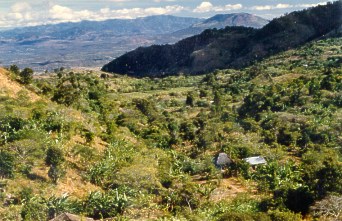 |
Aldea la Cumbre is a spread out village in the
mountains at an altitude of about 3500 ft. It is
an indigenous community of the Pocomam,
although very few now still speak Pocomam
presently. Houses, fruit trees (including the
jocote fruit the area is known for), sugar cane and
bananas cover the valleys and corn and beans
are grown in the hillsides. |
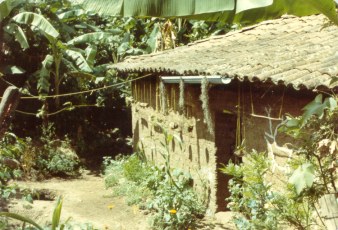
This was the house I rented while I lived in La
Cumbre. It had no running water (A spring
was located about 10 minutes walk.) These
was and is now no electricity to the area.
Running water is definitely harder to get used
to not having than electricity. You learn to
conserve and use runoff from the roof during
the rainy season. |
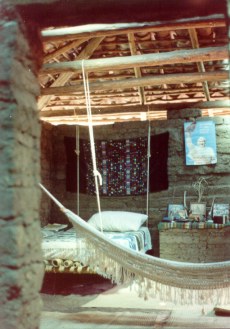 |
 |
These bus lines are the lifeline to these
isolated villages. Its how you get yourself and
everything you have in and out. They were
definitely chicken buses because chickens and
other livestock traveled with the people. On
market days they are loaded full with people
sometimes riding on top. It was 7 kilometers
(4.3 miles) from the two towns to where I
lived imbetween but it took the bus an hour to
cover this distance on the winding, mostly one
lane rough mountain road which would be
classified 4 wheel drive in places in the U.S. |
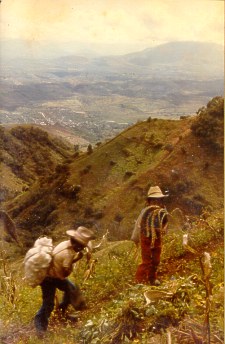 |
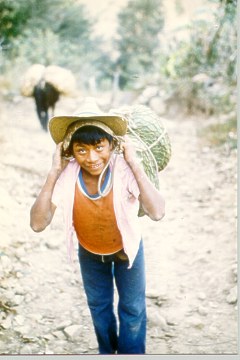
|
| Everything that's not brought in on a bus has
to be carried usually on your back since pack
animals are a luxury item. Here they are
carrying in corn from the fields on the steep
hillsides they farm. San Luis Jilotepeque is
down in the valley. |
This boy is carrying a type of melon using a
head strap called a cucucha. It looks really
uncomfortable, but in fact is quite easy and one can
carry an amazing amount of weight over long
distances using this method and not hurt ones
back. |

Kitchens tend to have a lot of venting to let
out the smoke. Cooking with firewood means
trees must be cut down and firewood
collected from farther and farther away. |

These two kitchens are typical with cooking
over an open fire on a raised platform. The
kitchen to the left is traditional and above is
an improved mud stove Peace Corps is
teaching. Kitchens are smoky, pots are clay,
but if done right food is safe. Notice how
food is kept up high. |

|
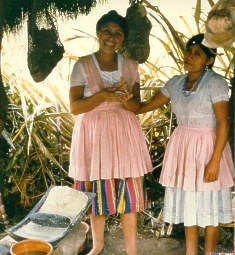 |
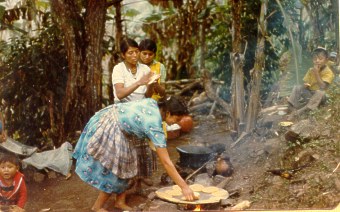 |
Tortillas are a major part of the diet rounded
of with beans, squash and coffee. Here they
are being made at a temporary sugarcane
camp. The corn is boiled in lime water till
soft. Then it is ground 2-3 times on the stone
grinding stones. The masa made from this is
patted into tortillas and cooked on a clay
griddle till they are done when the puff up in
the middle. The process takes about 2 hours
to complete. |
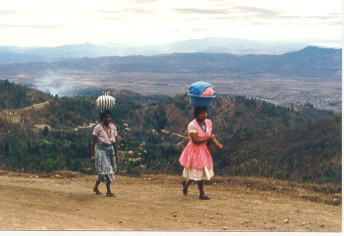
Women carry heavy loads on their heads. A
small piece of coiled cloth protects their heads
and stabilizes the load, but it still takes balance
and leaves them with excellent posture. Here
they are carrying water and laundry along the
main road and paths in the hills. Above the
older woman is in typical dress for the area,
while her daughter favors the more modern
bright dresses. |
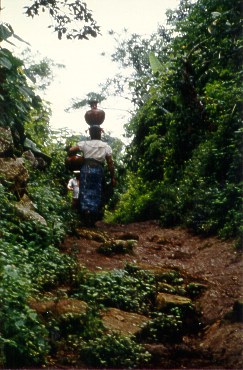 |
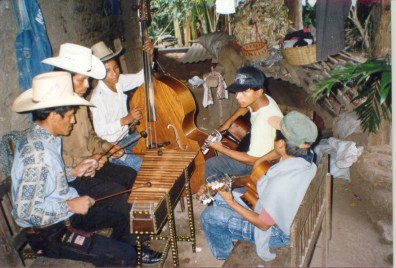 |
 |
| Local marimba band practicing. Dances are
held for most celebrations. |
Soccer is played constantly on any flat place.
The ball often is a homemade one made from
plastic bags and rope. |
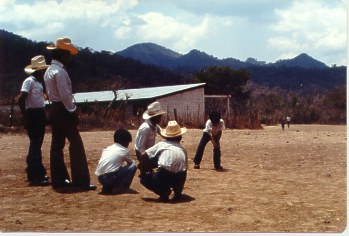 |
 |
| Marble games or canicas are also common. |
Local primary school behind with its teacher
and students. Many kids in the countryside
only finish 2 - 5 grades of schooling. |
 |
 |
| Horse race held during a celebration for Saint
Santiago's day. |
Workers returning from a hard day in the
fields with their crops. |
 |
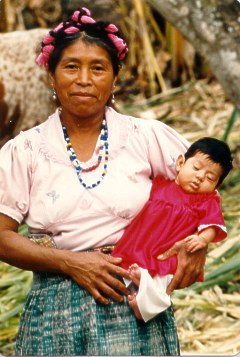 |
| Another local band playing traditional drum
and flute music. |
Woman and her grandaughter. |
 |
 |
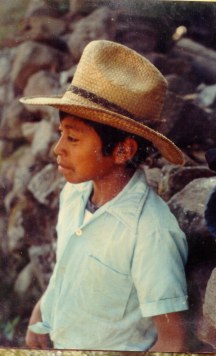
Local boys and girls from the area. |
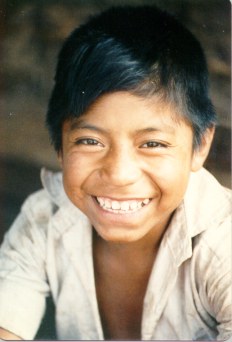 |
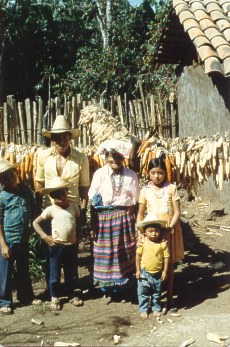 |
 |
| La cumbre family. The corn cobs behind are
the best selected and kept for next years seed. |
Another local family. |
 |
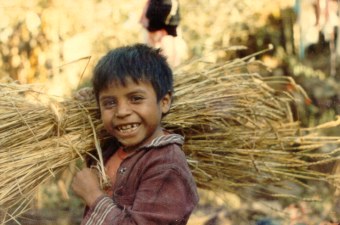 |
| I was the first outsider to ever live in this area and people were wary to afraid at first.
|
After a while everyone got very friendly and I was
sorry to leave the area after my two years. |
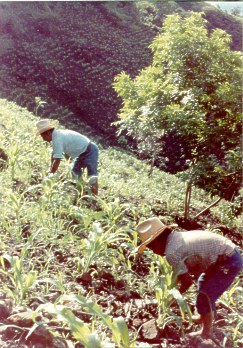
Corn is planted first on the hillsides during the
first rainy season in May/June and here its
being weeded. When the corn is maturing
beans are planted under the corn during the
second rainy season in August. |

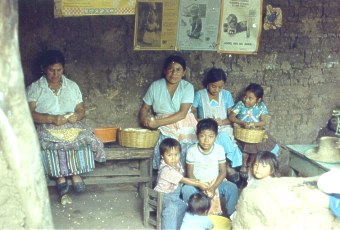
After harvest the corn is sorted and shelled for
storage. |
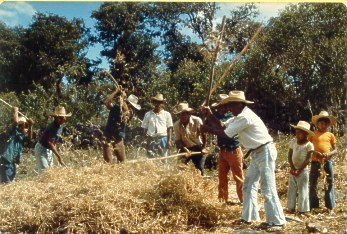 |
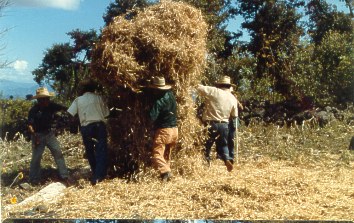 |
 |
The bean crop is much more of a community
activity. It is often planted in groups since
timing is very important. The second rainy
season is very short so the whole crop has to
be put in fast to take advantage of the little
water After the crop is dried down in the
fields the plants are pulled up and brought to a
flat spot in the field and laid on a tarp. Then
they are beaten with sticks to free the beans
from their pods. Afterwards the bean plants
and pods are lifted away from the beans. The
last job is to winnow the remaining chaff from
the beans pouring the in a light wind. Black
beans are the most popular in the countryside
of Guatemala, but red and white beans are
also grown. |
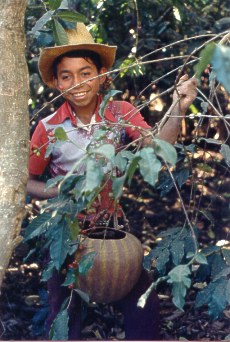 |
 |
| Picking coffee berries which are dried and
then the beans removed. |
Sweeping |
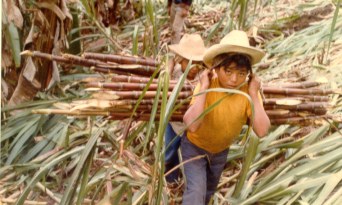 |
 |
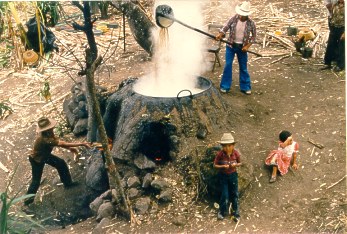 |
Sugar cane is grown in the wet areas in the
valleys. It is a crop that pretty much grows by
itself. When the cane is mature is is cut out
with machetes and carried into the processing
area. There the sugar juice is pressed out with
the help of oxen. It is cooked down in giant
pots all day being stirred constantly. After it
reaches a certain stage of boiling after much
testing it is collected at stages to make
molasses, sugar taffy and mostly poured into
molds for hard sugar used the rest of the year.
Your on a sugar high most of the time eating
soon much sugar. |
 |
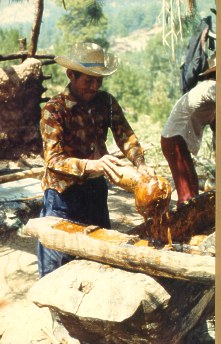 |
 |
 |
| Two styles of houses found in the area. This
is adobe and clay tile roof. Inside it has the
kitchen, bedroom and storage and a large
open roofed patio for entertaining visitors. |
This house is made of walls of sticks or corn
stalks with a roof of thatch. This is more of a starter house. |
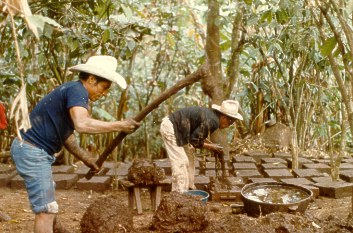
Adobes used in house construction are made
of mud and grass mixed in for strength. The
hardest part in making adobes is bring the
water to wet the dirt. |
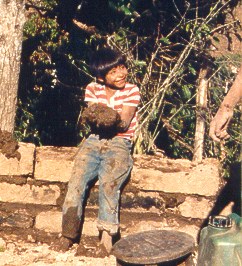 |
| The mud is made and poured in molds. After
the adobes are dry the walls of the house are
laid onto a stone foundation set into the
ground. Mud is used as mortar. Line levels
are used to keep the walls level and straight.
Houses are built during the dry season.
Timbers are laid on top of the walls for clay
tiles or a thatch roof. |
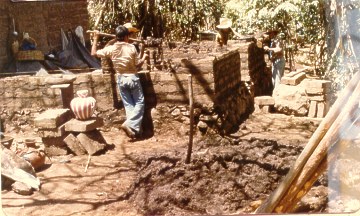 |
 |
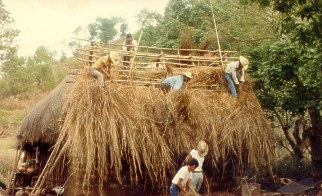
A thatch roof is formed from only certain
grasses cut and brought in from the hills. A
framework is made from wood or bamboo
and the cut grass is attached in layers. The
incline has to be steep so they do not leak.
The rainier the area the steeper the roofs. The
final job is to cut the ends off nice and neat at
the bottom. |
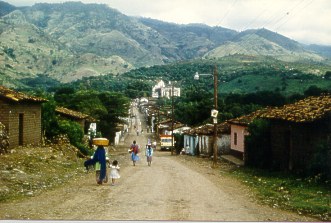 |
San Luis Jilotepeque is in the valley to the east
of La Cumbre mountains. The Jilotepeque
valley is known for black beans, peepers and
pottery - especially water jugs called cantaros.
Stone grinding stones are also med in this
town. San Luis has a large population of
Pocomam indians as well, but their typical
dress differs slightly from the typical dress in
La Cumbre. San Luis is quite a bit lower than
where I lived at an elevation of about 1000 ft. |
 |
 |

When the pots are finished they are packed up
in straw in these rope mesh bags and carried
or put on buses to markets all over
Guatemala. In Guatemala one needed to carry
big loads like these often as many areas are
roadless and public buses is the main form of
transportation. |
The clay rich soil in the Jilotepeque valley is
good for growing beans and pottery. The clay
is ground up for consistency, then wetted and
formed into pots. The three handled cantaros
from San Luis are renowned. Dishes and
bowls were also once commonly made in San
Luis. The pots are painted with a natural red
slip dug out of the nearby mountains and
decorated with traditional designs with a black
slip. They are then fired on the ground with a
fire of manure and straw. Since no graze is
used and firing is incomplete the water jugs
leak just a little though their sides so the sweat
when filled with water. This constant water
evaporation keeps the water pleasantly cool -
really nice on hot days with no refrigeration.
With plastics and running water this craft is
slowly dying. |
| Clay roof tiles called tejas are also made with
the nice clay found in the area. The clay is
mixed and flattened and cut into the shape
needed. Then the shape is formed over a
mold. After the clay dries they are fired. Clay
tile roofs are really nice in they let in diffuse
light during the day and are cool on hot days.
Their problems are if it rains for hours on end
they mist a little in the house and during an
earthquake they can be dangerous. |
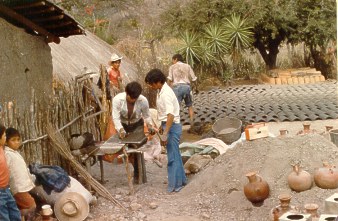 |
 |
 |
| Sunday was the market day in San Luis
Jilotepeque. Produce and foodstuff came in
from the countryside and other areas for
people to buy. These open air markets are the
way you kept yourself in fresh. food. Small
stores around the market also supplied
hardware, packaged goods, plastics and other
stuff as well, but the market items were often
fresher and cheaper. Bargaining is the norm
all over Guatemala. Bargaining doesn't upset
the seller in an area where its practiced, its
expected and a nice social activity as well. .
If you get them to agree to a good price you'll
get more respect. The green spiked vegetable
at the lower end is called a Guisquil . It is the
fruit of a local vine and is excellent in soups. |
These ladies are wearing the typical dress of
the indigenous people of San Luis
Jilotepepque. The dress is from cloth made in
Totonicapan with the tie died thread forming
patterns. The blouse is flowing with lace.
They often have a log white scarf which is
used to cover their heads from the sun, wrap
up items they are carrying or in the case of
younger women court with boys. A interested
boy with try to take the girls scarf. The less
she fights him the more interested. You'll see
young couples talking while in this tug of war.
Married women will also wrap their hair up in
two cords with black and red woven ribbon
and wrap it around their heads. They also
were lots of colored glass beads as they can
afford them. |
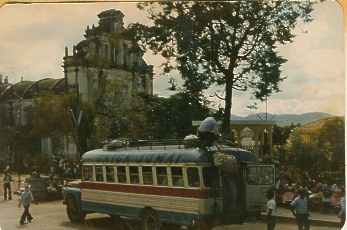 |
San Pedro Pinula was the East of La Cumbre
and formed the other valley on the side of
these mountains. San Pedro was the
government seat of the area where I lived.
Pinula valley was also very flat and used
mostly for cattle grazing on large estates
owned by ladino families (mixed
Spanish/indian blood). It is also known for
straw hats. Pinula has a old wild west fell to it
with cowboys, rodeos and occasional
shootings at bars. |
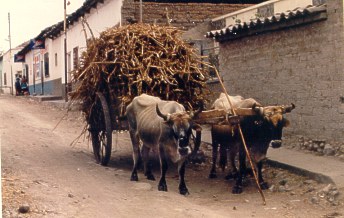 |
 |
| Oxen teams are used for heavy carts and labor
in this area. Some heavy tillage is also done
by oxen and well as providing the power for
sugar cane presses. |
The cattle hear are most criollo or native
breeds used for milk and meat production.
The cows are grazed during the day and
brought into pens in town every night for
protection, The civil war in Guatemala in the
60's started in this area. |
 |
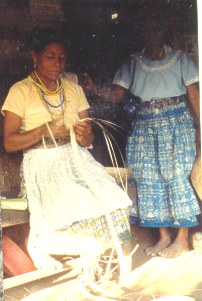 |
| The raw palm leaves sold in the Pinula market
These palm leaves come from other hotter
areas. They are then woven into strips or
trenchas by women all over the countryside.
This palm weaving is an important source of
cash income for these families. If you live in
subsistence agriculture you food is usually
covered, but for cash to buy things like salt
they need to sell something. These strips are
sold to hat makers in town that sew them into
hats. Some are all natural palm white and
sometimes designs are woven in using palm
leaves buried in mud to give them a brown
color. |
 |





























































